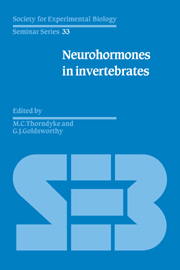Book contents
- Frontmatter
- Contents
- List of contributors
- Preface
- What is special about peptides as neuronal messengers?
- Part I Immunocytochemistry and Ultrastructure
- The new neurobiology – ultrastructural aspects of peptide release as revealed by studies of invertebrate nervous systems
- Immunocytochemistry of hormonal peptides in molluscs: optical and electron microscopy and the use of monoclonal antibodies
- Immunocytology of insect peptides and amines
- Immunocytochemistry and ultrastructure of crustacean endocrine cells
- Part II Arthropod Neurohormones
- Part III Neurohormones in Coelenterates, Annelids and Protochordates
- Part IV Neurohormones in Molluscs
- Index
Immunocytochemistry of hormonal peptides in molluscs: optical and electron microscopy and the use of monoclonal antibodies
Published online by Cambridge University Press: 04 August 2010
- Frontmatter
- Contents
- List of contributors
- Preface
- What is special about peptides as neuronal messengers?
- Part I Immunocytochemistry and Ultrastructure
- The new neurobiology – ultrastructural aspects of peptide release as revealed by studies of invertebrate nervous systems
- Immunocytochemistry of hormonal peptides in molluscs: optical and electron microscopy and the use of monoclonal antibodies
- Immunocytology of insect peptides and amines
- Immunocytochemistry and ultrastructure of crustacean endocrine cells
- Part II Arthropod Neurohormones
- Part III Neurohormones in Coelenterates, Annelids and Protochordates
- Part IV Neurohormones in Molluscs
- Index
Summary
Introduction
Study of model-systems has played a major role in the developments which have taken place in neurobiology during the past decades. Studies of opisthobranch and pulmonate molluscs have made important contributions in this area. These animals make excellent models, because they possess a relatively small central nervous system (CNS), which contains a limited number of large (polyploid, e.g. Boer et al., 1977) and readily accessible neurons. Two species have been studied in particular; the opisthobranch Aplysia californica (e.g. Strumwasser et al. 1980) and the pulmonate freshwater snail Lymnaea stagnalis (e.g. Joosse & Geraerts 1983; Roubos 1984).
Immunocytochemistry has become an important tool in neurobiology. In our laboratory the CNS of L. stagnalis has been investigated extensively using immunocytochemical methods (Boer et al., 1979, 1980, 1984a,b, 1986; Schot & Boer 1982; Schot et al 1981, 1983, 1984, see also Chapter 13, this volume). Recently monoclonal antibodies were raised to homogenates of whole CNS from L. stagnalis (Boer & Van Minnen 1985). These investigations, in conjunction with functional and electrophysiological studies can illustrate the central position of the peptidergic neuron in neurotransmission and in neuro-endocrine control processes (Joosse 1986).
Neural and hormonal communication
Animals possess two major systems for the regulation and coordination of body functions: the nervous system and the endocrine system. In the classic view these systems differ in a number of aspects. The chemical messengers of the nervous system (neurotransmitters) are small molecules (acetylcholine, biogenic amines, amino acids), which are released at sites of direct contact (synapse) between neurons and their targets.
- Type
- Chapter
- Information
- Neurohormones in Invertebrates , pp. 19 - 42Publisher: Cambridge University PressPrint publication year: 1988
- 3
- Cited by

